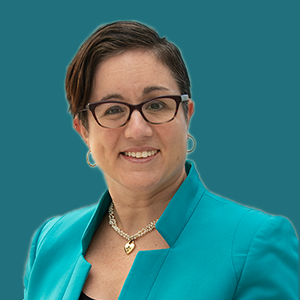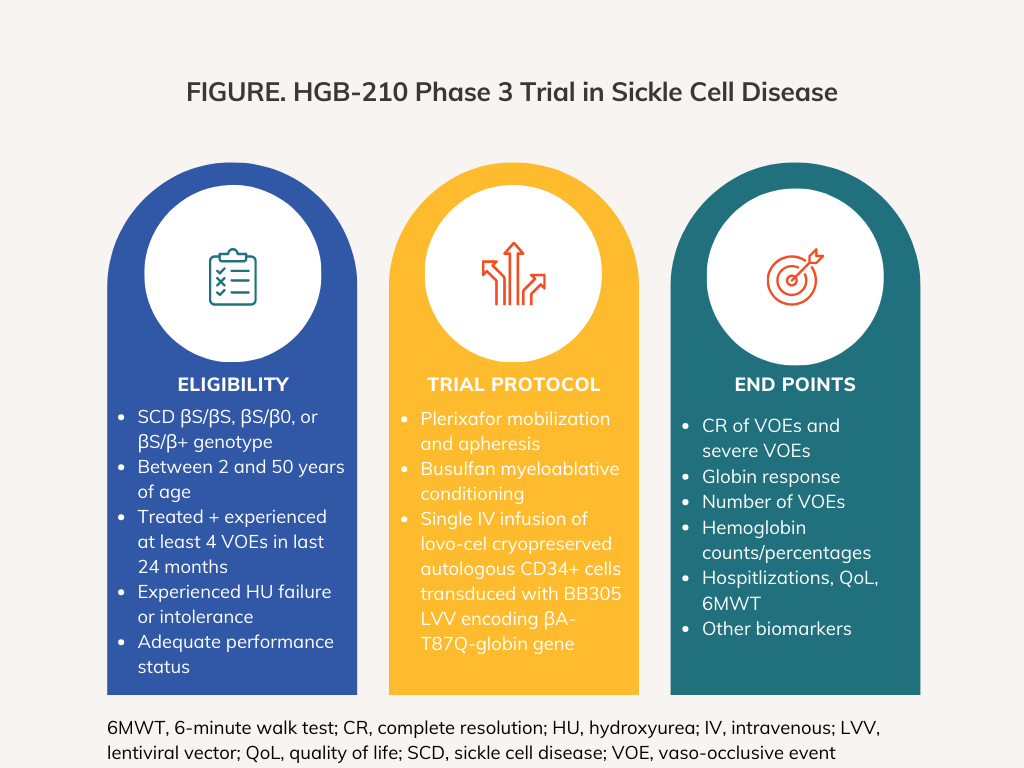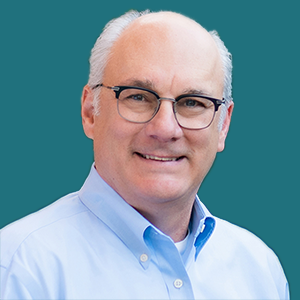bluebird's HGB-210 Trial Hopes to Support First SCD Gene Therapy Approval
Lovo-cel is currently being evaluated in the phase 3 HGB-210 study and has a PDUFA date of December 20, 2023.
Anticipation is building for lovo-cel (lovotibeglogene autotemcel; bluebird bio)’s Prescription Drug User Fee Act (PDUFA) goal date of December 20, 2023, and CGTLive is taking a look at the therapy’s turbulent course of development and clinical trials evaluating the therapy for the treatment of sickle cell disease (SCD).1
A Potential First Approval in SCD
Lovo-cel therapy consists of autologous CD34+ hematopoietic stem cells collected by plerixafor mobilization and apheresis, transduced with BB305 lentiviral vector (LVV) encoding the human beta-A-T87Q globin gene. It has been evaluated in the phase 1/2 HGB-205 (NCT02151526) and HGB-206 (NCT02140554) clinical trials, the former evaluating the therapy for both SCD and beta-thalassemia and the latter only involving participants with SCD. It is currently being evaluated in the phase 3 HGB-210 clinical trial (NCT04293185) for treating SCD.
Julie Kanter, MD

“I do support an approval; I think it's going to be very complicated, because we need to support SCD centers in delivering this product, as well as the product itself... I think it'll be a little bit complicated as we wander into this new territory of high-priced therapies,”trial investigator Julie Kanter, MD, director, Adult Sickle Cell Clinic and associate professor, hematology and oncology, University of Alabama Birmingham, told CGTLive. “But I think the patients that I have taken care of would tell you it is absolutely worth it. It is truly a transformative therapy."
HGB-210 Trial
The HGB-210 study is a single dose, nonrandomized, open-label, multi-center trial in approximately 35 adults and pediatric participants between the ages of 2 and 50 years with SCD. Participants must have βS/βS, βS/β0, or βS/β+ SCD, have adequate performance status by Karnofsky or Lansky, have been treated with detailed records for 24 months before informed consent and experienced at least 4 vaso-occlusive events (VOEs) during this time, experienced hydroxyurea failure, and use contraception during the study. Participants receive a single dose of lovo-cel by intravenous infusion following myeloablative conditioning with busulfan. (FIGURE).
(Click to enlarge)

The primary outcome of the study is complete resolution of VOEs 6-18 months after treatment. Secondary outcomes assessing efficacy include the complete resolution of severe VOEs in the same time frame; globin response of at least 30% HbAT87Q weighted average of non-transfused total hemoglobin (Hb) and an increase of over 3 g/dL of weighted average non-transfused total Hb or reaching over 10 g/dL; a change in the annualized number of VOEs and severe VOEs in the next 24 months as compared to the 24 months before informed consent; complete resolution of VOEs and severe VOEs between 6 and 24 months post treatment; and at least a 75% reduction in annualized severe VOEs in the 24 months after treatment.
READ MORE: 2023 World Sickle Cell Day: The Home Stretch for Gene Therapy in SCD?
Secondary outcomes are also assessing biomarkers at time periods up to 24 months posttreatment of nontransfused total Hb, HbS percentage, HbAT87Q percentage, non-HbS percentage, reticulocytes, erythrocytes, bilirubin, haptoglobin, lactate dehydrogenase, ferritin, liver and cardiac iron, erythropoietin, and serum transferrin receptor. Other measures of efficacy being evaluated as secondary outcomes include the annualized volume and frequency of packed red blood cell transfusions, Transcranial Doppler velocity, 6-minute walk test distance, SCD-related hospital admissions and days hospitalized, and patient reported quality of life.
Phase 1/2 Trials and BLA Submission
bluebird bio submitted its biologics license application (BLA) for lovo-cel in the SCD indication in April 2023. The company later announced that an FDA advisory committee meeting would not be scheduled for reviewing lovo-cel.
Mark Walters, MD

"The clinical trials were stunningly successful in that they showed that the treatment generated no new unexpected toxicities related to the lentiviral vector that delivers the healthy copy of the antisickling globin gene that creates HbAT87Q that mimics fetal hemoglobin in its inhibition of intravascular sickling,” trial investigator Mark Walters, MD, professor in residence, pediatrics, Sickle Cell Center of Excellence, University of California San Francisco, told CGTLive. “So, the main takeaway from the clinical trials was that in most of the patients, the severe, painful VOEs that had been causing hospitalizations and trips to the emergency department before they received the treatment, were eliminated. And since pain is a hallmark of SCD, this was a phenomenal observation and I think is the basis for what we predict will be approval of the drug.”
The BLA submission is mainly supported by efficacy data from 36 patients in the Group C cohort of the HGB-206 study with a median follow-up of 32 months. The phase 3 HGB-210 study has contributed data from 18 months of follow-up on 2 patients. bluebird has stated that these 2 patients have received the treatment and have been doing well, but have not released any specific data. The latest data on lovo-cel were current as of August 2022 and presented by Walters at the 64th American Society of Hematology (ASH) Annual Meeting in December 2022.2 Lovo-cel demonstrated a 96% rate (n = 31) of complete resolution of severe VOEs in patients treated in Group C of HGB-206 through 24 months of follow-up compared with 3.5 events per year in the 2 years prior to study enrollment.
All patients in Group C had median vector copy number in peripheral blood remain stable at 1 c/dg or more 6 months post-infusion through last study follow-up, which resulted in median HbAT87Q levels of 5 g/dL or more. Baseline median total hemoglobin increased from 8.5 g/dL to 11 g/dL or more at 6 months through last visit, with no transfusions. Notably, HbAT87Q accounted for more than 40% of total hemoglobin. A single sVOE occurred in the adult patient with persistent anemia, and as of 24-month follow-up, that patient is transfusion-dependent and experiences intermittent chronic pain. A pediatric patient developed persistent, nontransfusion-dependent anemia, but has not required transfusion and remains well. Both patients did experience a reduction or resolution of sVOEs following treatment with lovo-cel. Besides these 2 serious adverse events (AEs), frequent AEs include pain, abdominal pain, anemia, drug withdrawal syndrome, nausea, suicidal ideation, and vomiting, with no cases of veno-occlusive liver disease, graft failure, insertional oncogenesis or replication-competent lentivirus.
The case of persistent, nontransfusion-dependent anemia prompted a partial clinical hold by the FDA in December 2021 lifted a year later barring it from enrolling patients under the age of 18. Another pediatric patient later developed the same condition, although further studies have concluded that the cases do not indicate clonal evolution or an emerging malignancy and may be attributable to 2 α-globin gene deletions. The patients entered the study with anemia, suggesting that the trait may contribute to anemia and dyserythropoiesis after treatment with lovo-cel.3
Access Issues Undermine Progress in SCD Research
While clinicians in the field are excited by the predicted approval of lovo-cel, Kanter and Walters noted that underlying health disparities and access issues must be addressed to truly benefit the population of SCD. While the therapy has the potential to transform the field, its impact will be limited as long as many patients with SCD struggle to receive even the current standards of care for the disease.
"The first gene therapy, approved for sickle cell disease is really a landmark experience but this is not the finish line. [The field] will continue to evolve and improve, I predict, as we get better at manipulating the genome, and doing so with hematopoietic stem cells. So, I really look forward to the future. I think some patients will definitely benefit from this, but I predict future products will be the ones that will have the most impact."
-Mark Walters, MD
“It's most important to recognize that this will change the field slowly. So, we need to keep doing everything we're doing now, for individuals with SCD, recognizing they face horrible stigma and health disparities. And we need to continue to address those and ensure not just that people have access to cell and gene therapy, but that they have access to an SCD specialist first and foremost... I think what's most important right now is that we get every individual living with SCD to a specialist to be evaluated for all kinds of therapies that might help them,” Kanter said.
Kanter, who is also president of National Alliance of Sickle Cell Centers (NASCC), urges any patients or referring clinicians to visit www.sicklecellcenters.org to view a map of NASCC-recognized centers to help connect every individual with SCD to a specialist.
